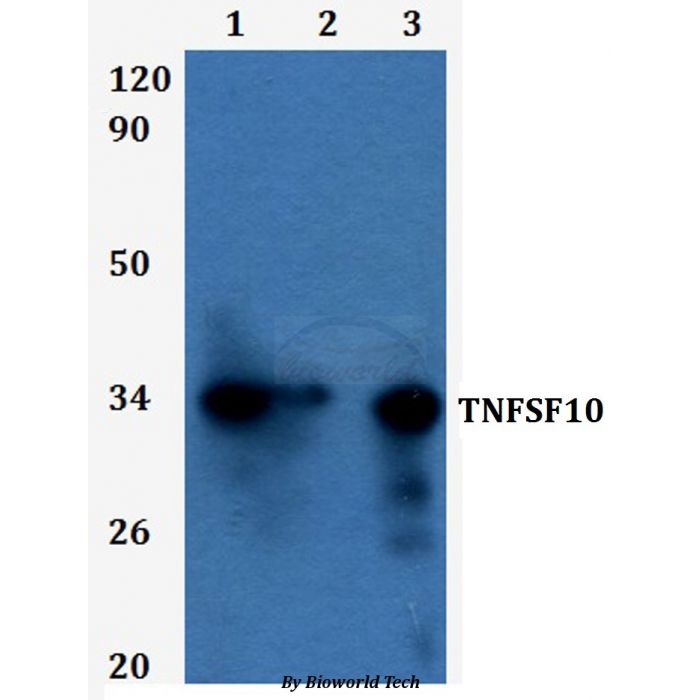CD253 (TNFSF10) polyclonal, anti-human, mouse, rat
€305.00
In stock
SKU
BS60933
Background:
Proteins belonging to the tumor necrosis factor (TNF) superfamily are potent mediators of the inflammation and immune systems. Members of the TNF superfamily include TNFβ, lymphotoxin β (LTβ), CD40L, CD30L, CD27L, Ox40L, 4-1BBL and FAS-L (Apo-1). Most TNF family members are type II transmembrane proteins that are proteolytically processed at their carboxy-terminal extracellular domain to form a soluble homotrimeric molecule. The extracellular domain of an additional TNF family member, designated TNF-related apoptosis-inducing ligand (TRAIL) or Apo-2L, exhibits 14-28% homology with other members of the TNF family. Like soluble FAS-L, soluble TRAIL will induce apoptosis. The morphological and cellular changes caused by the introduction of soluble TRAIL to Jurkat cells are indistinguishable from those caused by the introduction of soluble FAS-L. Unlike FAS-L, whose expression is more or less restricted to activated T cells, significant levels of TRAIL are observed in many tissues and it is constitutively expressed by some cell lines.
Alternative Name:
Tumor necrosis factor ligand superfamily member 10, Apo-2 ligand, Apo-2L, TNF-related apoptosis-inducing ligand, Protein TRAIL, CD253, TNFSF10, APO2L, TRAIL
Application Dilution: WB: 1:500~1:1000
Specificity: TNFSF10 polyclonal antibody detects endogenous levels of TNFSF10 protein.
Immunogen:
A synthetic peptide corresponding to residues in Human TNFSF10.
MW: ~ 34 kDa
Swis Prot.: P50591
Purification & Purity:
The antibody was affinity-purified from rabbit antiserum by affinity-chromatography using epitope-specific immunogen and the purity is > 95% (by SDS-PAGE).
Format:
1 mg/ml in Phosphate buffered saline (PBS) with 0.05% sodium azide, approx. pH 7.3.
Storage:
Store at 4°C short term. Aliquot and store at -20°C long term. Avoid freeze-thaw cycles.
For research use only, not for use in diagnostic procedure.
Proteins belonging to the tumor necrosis factor (TNF) superfamily are potent mediators of the inflammation and immune systems. Members of the TNF superfamily include TNFβ, lymphotoxin β (LTβ), CD40L, CD30L, CD27L, Ox40L, 4-1BBL and FAS-L (Apo-1). Most TNF family members are type II transmembrane proteins that are proteolytically processed at their carboxy-terminal extracellular domain to form a soluble homotrimeric molecule. The extracellular domain of an additional TNF family member, designated TNF-related apoptosis-inducing ligand (TRAIL) or Apo-2L, exhibits 14-28% homology with other members of the TNF family. Like soluble FAS-L, soluble TRAIL will induce apoptosis. The morphological and cellular changes caused by the introduction of soluble TRAIL to Jurkat cells are indistinguishable from those caused by the introduction of soluble FAS-L. Unlike FAS-L, whose expression is more or less restricted to activated T cells, significant levels of TRAIL are observed in many tissues and it is constitutively expressed by some cell lines.
Alternative Name:
Tumor necrosis factor ligand superfamily member 10, Apo-2 ligand, Apo-2L, TNF-related apoptosis-inducing ligand, Protein TRAIL, CD253, TNFSF10, APO2L, TRAIL
Application Dilution: WB: 1:500~1:1000
Specificity: TNFSF10 polyclonal antibody detects endogenous levels of TNFSF10 protein.
Immunogen:
A synthetic peptide corresponding to residues in Human TNFSF10.
MW: ~ 34 kDa
Swis Prot.: P50591
Purification & Purity:
The antibody was affinity-purified from rabbit antiserum by affinity-chromatography using epitope-specific immunogen and the purity is > 95% (by SDS-PAGE).
Format:
1 mg/ml in Phosphate buffered saline (PBS) with 0.05% sodium azide, approx. pH 7.3.
Storage:
Store at 4°C short term. Aliquot and store at -20°C long term. Avoid freeze-thaw cycles.
For research use only, not for use in diagnostic procedure.
| Is Featured? | No |
|---|
Write Your Own Review

